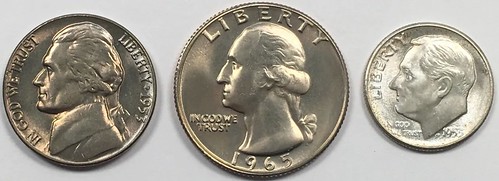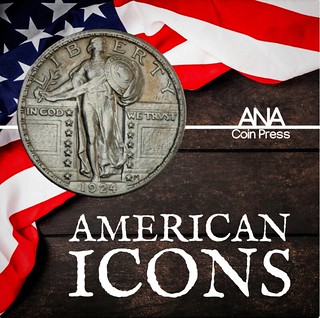
PREV ARTICLE
NEXT ARTICLE
FULL ISSUE
PREV FULL ISSUE
U.S. COIN DESIGNS: YESTERDAY, TODAY, TOMORROW??This June 2020 ANA blog post by Mitch Sanders is timely; it discusses how the designs on our coins have evolved over the centuries. -Editor
Liberty’s place on American money dates back to the establishment of the U.S. Mint in 1792. Things could have turned out very differently, though, because an early proposal would have placed portraits of the current President on American coins. After significant legislative debate, with expressions of concern for what some considered a monarchical practice, Liberty was chosen as a more appropriate symbol for the new nation. Each American coin was required to carry an emblematic image of Liberty, along with the word LIBERTY. For the next century and a half, nearly all U.S. coins featured allegorical representations of Liberty. Most portrayed a portrait bust of a female figure, with variations in features and hairstyle. She is sometimes seen with a liberty cap—an ancient symbol of emancipation—or wearing an Indian headdress. Images of a seated Liberty dominated 19th-century silver coinage. Beginning in the early 20th century, Liberty was depicted in a wider variety of poses and guises. She holds a shield and an olive branch on the Standing Liberty quarter, walks with the rising sun while draped in a flag on the Walking Liberty half dollar, and strides forward bearing a torch and an olive branch on the Saint-Gaudens double eagle ($20). She wears a spiked crown on the Peace dollar and a winged cap— representing freedom of thought—on the Winged Head Liberty dime (also known as the “Mercury” dime). These classic designs are widely considered to be among America’s finest examples of numismatic art. But over the course of the last century, allegorical images of Liberty on circulating coins have been replaced by portraits of historical Americans. In the 21st century only the Statue of Liberty, on the reverse of Presidential dollars, has represented her allegorical predecessors.
To read the complete article, see:
On a more contemporary note, Ron Guth published a related piece on his Numismatic Detective Agency blog this week; here's a lengthy excerpt. Are America's Classic Coin Designs Endangered? -Editor 
In recent weeks, political activists have vandalized or destroyed historical American statues and monuments and have called for the destruction of many more. It seems that any offense, even an insignificant one, now justifies cancelling from history anyone who, for example, fought in the Confederacy, owned slaves, fought against indigenous Americans, made a racist expression or a politically incorrect statement. I’m not here to defend any bad actors or to minimize past injustices, but to warn the numismatic community that we could be next. What does this have to do with coins? Well, some of the “bad actors” that have been targeted by activists include numismatic favorites such as George Washington and Thomas Jefferson (slave-owners), Ulysses S. Grant (acts against native Americans), Christopher Columbus (genocide of native Americans following his “discovery” of America), and even the great Emancipator, Abraham Lincoln (racist comments). If you think it can’t happen, look at what atheists and state/religion separatists have already tried to do with the motto “In God We Trust” on American coins. What will happen when political activists discover that the coins in their pockets memorialize their targets? If any offense justifies the removal of historical figures, there are a host of American coins that could be subject to “cancellation.” What would cancellation look like? First, would be the removal of objectionable portraits from existing coins and paper money. Second, would be the banning of trading in such coins. Third, would be the removal from circulation and destruction of any offending coins. Here are just a few coins that are subject to cancellation and why: 1792 “Martha Washington” Half Disme. The nickname alone justifies its cancellation because Martha was a slave-owner and married to one. 1859-1909 “Indian Head” Cent. The offense of this designer was to culturally appropriate a Native American headdress and, according to legend, place it on the head of his white daughter. 1909-Date Lincoln Head Cent. Even though Lincoln freed the slaves, many of his comments concerning them were downright racist. 1892-1893 Columbian Exposition Commemorative Half Dollar. The impact of Columbus’ discovery of the Americas is characterized as one of genocide and subjugation. 1893 Columbian Exposition Commemorative Quarter Dollar. Guilt by association – Queen Isabella funded Christopher Columbus’ trips of exploration. 1938-Date Jefferson Nickel. Slave-owner. 1913-1938 “Buffalo Nickel. More cultural appropriation. 1946-Date Roosevelt Dime. Franklin Roosevelt put Japanese-Americans in internment camps. 1932-Date Washington Quarter Dollar. Slave-owner. 1922 Ulysses S. Grant Commemorative Half Dollar. Subjugation of the Plains “Indians.” 1925 Stone Mountain Commemorative Half Dollar. Depicts Confederate Generals Robert E. Lee and Stonewall Jackson. Arguments for cancellation could be made for many more American coins, especially among the Commemorative series. Taken to the extreme, just about any American coin could be considered offensive. Republicans could be offended that the Kennedy Half Dollar favored a Democrat. Women could be offended by the various depictions of Miss Liberty, especially those by male engravers. Animal rights activists could be offended by the various anthropomorphic depictions of eagles with scrolls in their beaks or olive branches in their talons. Peace activists could be offended by eagles with arrows in their talons or Civil War Tokens depicting elements of war. Circulating coins, like statues, are out there in the public domain daily. Anything touching the public at large is liable to get swept up in politics at one point or another. George Washington's position of NOT wanting his portrait on our nation's first coins was itself a political statement - a defiance of the institution of monarchy he'd led a war against. Yet times change. People DO want to honor their heroes, even reluctant ones. And one by one generic representations of Liberty have yielded to portraits of former leaders, even Washington himself. And times may well change our change again. We see the political tug-of-war over a new portrait for the $20 bill, and we may well see calls for a new generation of heroes on our coins. Destroying or banning the trading in newly offensive coins is quite unlikely I think, but coins can get caught up in general bans such as those on Nazi imagery, and it's already illegal to sell Medals of Honor in the U.S. Some commentators marveled at the indiscriminate nature of the recent rioting. "When mobs tore down a statue of Ulysses S. Grant and defaced a monument to African-American veterans of the Civil War, many people wondered whether the protesters had ever learned anything in high school or college. Did any of these iconoclasts know the difference between Grant and Robert E. Lee? " (From National Review. As Ron notes, the beef with Grant may be over his defeat of native americans rather than his defeat of Robert E. Lee, the Confederacy, and slavery. Those of us with knowledge and experience in numismatics need to be voices of reason in the discussion to prevent any unnecessary overreach. But we should also be open to discussing proposed design changes. -Editor
To read the complete article, see:

Wayne Homren, Editor The Numismatic Bibliomania Society is a non-profit organization promoting numismatic literature. See our web site at coinbooks.org. To submit items for publication in The E-Sylum, write to the Editor at this address: whomren@gmail.com To subscribe go to: https://my.binhost.com/lists/listinfo/esylum All Rights Reserved. NBS Home Page Contact the NBS webmaster 
|
